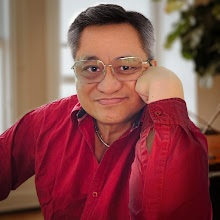
One of the booths at the Christmas Village.
“SMALL” WAS the first thing I thought of when we entered the Manila F.A.M.E. International 2007 pavilion containing the Christmas exhibition. In 1998, the last time I visited Manila F.A.M.E., the pavilion was compact and busy. Today, aisles were wide and booths were few. I learned later that several exhibitors backed out this year for financial and logistical reasons. Now on its 23rd year, the Manila Furnishings and Accessories Manufacturers Exhibition remains Southeast Asia's largest trade show on houseware, home furnishings, holiday décor, and fashion accessories. Held twice annually, the show is a marvelous showcase of the transformation of indigenous materials into contemporary, innovative product design by exporters and designers from the Philippines. But not everything is handcrafted. Some exporters have started producing fiberglass and resin materials to meet mass production demands. This is regretful as the products lose their unique sense of craftsmanship. Regretfully, we can expect this concession to happen in greater volumes as China gains momentum as a global export centre for inexpensive mass-produced consumer products. We hopped over to the fabulous fashion accessories pavilion, but moved on quickly as we had no business with this category. At the home furnishings pavilion, Bembem and Neha waxed ecstatic over discovering the avant-garde use of such indigenous materials as sinamay and capiz shells. I sensed a love affair blossoming between capiz shells and these two Indian ladies. Most of the furniture was designed to encourage dialogue between furniture users. A rocking chair became a dual swing for two. A chaise longue was converted into a double settee. Reimon Gutierrez, a designer I have always admired, had amongst the most engaging pieces. One of his items was a novel translation of the rattan peacock chair: the traditional single seat became a grand two-seater without digressing from the basic form. When Miss Spain was crowned Miss Universe in Manila in 1974, she sat on a peacock chair. With Mr. Gutierrez’s new chair, even the beauty contest runners-up can sit with the winner! Past Post: Date With a Giant At the Christmas pavilion, a huge covered booth at the entrance displayed the best of this year’s décor and accessories. Everywhere else, the export products were dazzling. We were particularly impressed with the handcrafted angels and crèche figures. Hopefully, I can close a deal with these vendors so India can see Philippine-made materials at our window displays this coming Christmas.
At the Christmas pavilion, a huge covered booth at the entrance displayed the best of this year’s décor and accessories. Everywhere else, the export products were dazzling. We were particularly impressed with the handcrafted angels and crèche figures. Hopefully, I can close a deal with these vendors so India can see Philippine-made materials at our window displays this coming Christmas.
Bembem and Neha in front of the Christmas Village pavilion.
Admiring a tribal hand loom demonstration at the Home Furnishings pavilion.
Preparing papier-mâché masks for the Higantes festival.
At the main lobby of the exhibition.
Next Post: Jeepney Ride

